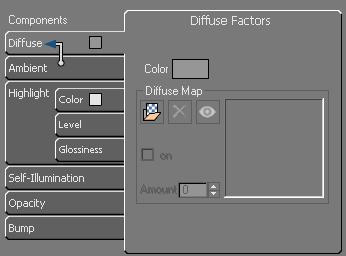
The tabs at the bottom of the Material Editor dialog control the settings, or "factors," of the material's eight components. To access the settings of a particular component, click its tab. The panel on the right shows the factors for that component.

Each component's tab includes bitmap controls. This topic describes the controls that are specific to each particular component.
If a component has a color assigned to it, a small color swatch appears in its tab.

Component colors displayed in component tabs
If a component has a bitmap assigned to it, a small checkered bitmap icon appears in its tab.

Bitmap icons displayed in component tabs
You can drag and drop the tabs' color swatches or bitmap icons, as described in Procedures, below.
See also
Procedures
To copy a color from one component to another:
Drag the small color swatch from one tab to the other.
The color you dragged replaces the target component's original color.
To copy a map from one component to another:
 Drag the checkered bitmap icon from one tab to the other.
Drag the checkered bitmap icon from one tab to the other.
The bitmap represented by the icon you dragged replaces the target component's previous bitmap.
Note: If the ambient component is set to match the diffuse component, you can't change the ambient color or mapping. The same applies to the specular component when it is set to match diffuse.
Interface
Diffuse Factors
Color: Controls the diffuse color. The diffuse color is the color in direct light.
Click the swatch to display the Color Selector dialog and choose a diffuse color.
Ambient Factors
Color: Controls the ambient color. The diffuse color is the color in direct light.
Click the swatch to display the Color Selector dialog and choose an ambient color.
Match Diffuse Color/Map: When on, the ambient color is controlled by the Diffuse component, and you can't choose a specular color or map from this tab.
When this setting is on, an arrow in the tabs indicates that the two components are locked together.

Highlight Factors
Clicking the large Highlight tab displays the highlight controls. In addition to the highlight controls, there are three sub-tabs: Color, Level, and Glossiness.
Color: Controls the specular color. The specular color is the color of the highlight on a shiny object.
Click the swatch to display the Color Selector Dialog and choose a specular color.
You control the size of highlights using the highlight controls.
The Color sub-tab has an additional sub-control:
Match Diffuse Color/Map: When on, the ambient color is controlled by the Diffuse component, and you can't choose an ambient color or map from this tab. When this setting is on, an arrow in the tabs indicates that the two components are locked together.

Level: This sub-tab lets you assign a map to the specular level component.
Glossiness: This sub-tab lets you assign a map to the specular level component.
Self-Illumination Factors
There are two ways to specify self-illumination: either by a value, or by a color. The check boxes let you select which method to use.
Amount: The diffuse component is used as the self-illumination color. The spinner lets you adjust the amount of self-illumination. At 0, there is no self-illumination. At 100, the diffuse color takes over from the ambient color.
Color: The self-illumination color can be different from the diffuse color. Click the swatch to display the Color Selector dialog and choose a self-illumination color. Adjusting the Value (in the color's HSV description) adjusts the amount of self illumination. The greater the Value, the more the self-illumination color dominates both the diffuse and ambient color components.
Opacity Factors
Amount: Sets the opacity/transparency of the material as a percentage. At 0, the material is completely transparent. At 100, it is completely opaque.
Bump Factors
The only factors for bump are the bitmap controls. See Mapping Material Components for a description of how bump mapping affects a material.
Note: Bump mapping does not appear in viewports, and is supported only by certain game engines.